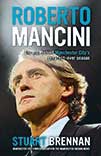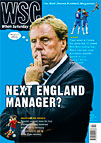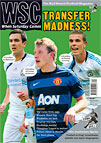Search: ' Sampdoria'
Stories
When the Irishman arrived at Highbury he quickly went about shedding Arsenal’s “boring” tag, as Mike Baker explained in WSC 22, December 1988
 The man behind Manchester City’s
greatest ever season
The man behind Manchester City’s
greatest ever season
by Stuart Brennan
Andre Deutsch, £16.99
Reviewed by Matthew Barker
From WSC 310 December 2012
Roberto Mancini was a gloriously gifted player. He was also stroppy; prone to outbursts and sulks that frequently alienated him from coaches of club and country and, occasionally, some of his team-mates. Now, as a manager himself, he has to deal with players who can comfortably outdo him on the ego and attitude fronts.
The first 100 pages or so of Stuart Brennan’s book are dedicated to Mancini the footballer, particularly his time at Sampdoria. Mancini’s contention that he was actually a midfield playmaker, rather than an out-and-out striker, caused him problems throughout his playing career. His great vision and unfailing talent for placing the ball where he wanted won him endless plaudits, but fallings out with a succession of Azzurri coaches and a surfeit of Italian attacking talent put the blockers on his international career.
Bar a few stand-out howlers – claiming the Calciopoli scandals took place “six years after” Italia 90, for one – the main problem here is the author’s drawn-out, clumsy theory that Mancini has always sided with the underdog, and that his notorious stubbornness is actually the stuff of an anti-establishment rebel (this despite him being a boyhood Juventus fan).
We are told that his move to Sampdoria in 1982, after a debut season with Bologna, “appealed to his sense of destiny” and that the Genovese club – a “provincial footballing backwater” apparently – provided the perfect platform for someone keen to topple the established Serie A order. And yes, it’s pretty obvious where we’re going with this one.
Less time is spent looking at Mancini’s time in Italy as a coach, which is a pity. The traumas of a first job in charge of Fiorentina, when the club were edging towards bankruptcy and demotion to the old Serie C, are dealt with in a few paragraphs, as is his equally troubled stint at Lazio. Brennan is itching to get to the bit where Mancini takes charge at Inter, so he can triumphantly point out that Nerazzurri are sort of, a bit, kind of like Manchester City. And Milan just like Manchester United. Perfect. Except, of course, they’re not.
The claim that il Mancio was sacked by an “ungrateful” and “impatient” Inter after three post-Calciopoli championship wins is hugely misleading. Most Italian commentators (and did Brennan really not think to speak to one?) believe the coach engineered his move away from the club and that his bluff was called after he reportedly told players he was going to Chelsea following Inter’s 2008 Champions League exit against Liverpool.
Instead of the promised insight and examination, we get a decidedly uncritical portrait; there is little analysis of the handling of Carlos Tévez. The relentless blandness of Mancini’s press conference quotes are interspersed with uninspiring, cut-and-paste retellings of events from the past couple of years, stuff that anyone with a passing interest in British football, never mind Manchester City supporters, surely knows well enough already.
We’re told those City fans are “in delirium”, some lucky ones are even “in ecstasy”, and surely no one can begrudge them that? Brennan sees his subject’s habitual grumpy aloofness as a positive, proof that he’s willing to fight his corner. However, a more searching assessment of Mancini, both as a man and a manager, could have flagged up warning signs of potential troubles ahead.
 Dear WSC
Dear WSC
The article on the FA Cup’s longest tie (Draw to a close, WSC 298) reminded me of what I believe is still officially the longest single match between two English sides – the second leg of a Division Three cup tie between Stockport County and Doncaster Rovers on March 30, 1946. After extra time, the score stood at 2-2 – which was also the score following the first leg. Having checked with the local authorities, the referee let the game carry on until one team scored, the original Golden Goal. After 203 minutes and with darkness setting in, the match was finally brought to an end. The story goes that fans left the match to go home for their tea and returned later to carry on watching. The replay at Doncaster was won by the home team 4-0. This might not be quite as impressive as the longest football match ever, which I believe currently standards at 57 hours. This epic encounter between Leeds Badgers and Warwickshire Wolves in 2010 was played to raise money for charity.
Alan Bredee, Enfield
 Mysterious foreign signings don’t always live up to heightened expectations. Andy Clark recalls how Dundee United fans found out the hard way
Mysterious foreign signings don’t always live up to heightened expectations. Andy Clark recalls how Dundee United fans found out the hard way
When Dundee United manager Jim McLean attempted to exploit the South American transfer market in 1991, his hope of bringing the next Gabriel Batistuta to the banks of the Tay didn’t quite work out as planned. In the early nineties, the formidable side United had become over the previous two decades began to falter. With an increased number of foreign players arriving in Scotland along with the recent Souness revolution at Rangers and growing pressure from fans for a big money signing, McLean decided to go international.
So it was in August 1991 that Dundee United announced the signing of ‘flying Argentinian winger’ Walter Rojas, a twenty-year old with dark flowing locks and “blistering pace”, from Buenos Aires club side San Lorenzo for a reported fee of £200k. United had apparently beaten off a host of clubs including Sampdoria and Foggia for the Argentine under-21 international signature. “El Explosivo“, as he had been nicknamed in his home country, was unveiled in a blaze of publicity. Fans were assured his debut would be imminent.
Then it all went very quiet. Weeks passed without any sign of the new long-haired wing wizard. According to the club, he had damaged a thigh muscle in training. However, rumours were circulating that Rojas might not be the player everyone thought he was. Opinion was rife in the city he was a “duffer”, apparently being taken to the cleaners by the reserve and youth team players in training. After almost three months, Rojas finally turned out for the reserves against Aberdeen in what proved to be his solitary appearance in a tangerine shirt and was well short of the standard required. One fan later claimed he had only two decent crosses in the game “when he blessed himself coming on and off the park”.
Then the conspiracy theories began. One source claimed United had been the victim of mistaken identity and had signed the wrong player. Another alleged that McLean had seen video footage of a prolific striker and was keen to sign him. A deal was negotiated but the player didn’t fancy the move so United were offered Rojas and took a chance.
Whatever the truth, United had been done. Rojas had only been a reserve team player at San Lorenzo and had played a mere four times for the first eleven in four years. Despite being inconspicuous by his absence on the park, there was no shortage of sightings of the player off it. ‘Rojas-spotting became a popular pastime with United fans in and around the city. “I used to see him in Buddies (a popular nightclub)” remembers one “he was strangely fond of having his jumper draped over his shoulders”. Another spotted him at a wedding in nearby Broughty Ferry.
I also had the thrill of encountering Rojas at the Megabowl Leisure Complex in Dundee. He looked slightly embarrassed and kept diverting my attention to the guy he was with. “Victor…this Victor,” he repeated in broken English. I thought nothing of it. He turned out to be Argentinian international Victor Ferreya, signed by United that day. Rojas clearly knew he was something of a fraud and had been embarrassed by all the attention whilst his new team-mate’s arrival appeared to have gone un-noticed. Rojas and Ferreya; were also invited to the Glenrothes Arabs player of the year dance. “They turned up in shell-suits, won nearly all the raffle prizes then swiftly fucked off back to Dundee,” recalled a witness.
Rojas returned to San Lorenzo then played for another three Argentine clubs before ending his career with Uruguayan side Huracan Buceo in 2000. Despite never playing a first team game, he achieved cult status among Arabs, as United fans are known. His moniker appears in a range of guises as usernames on messageboards and he has become a by-word for a duff foreign signing (and there have been plenty).
Twenty years on, McLean finally broke his silence on the bizarre episode. Rojas apparently only cost United an air fare and a few week’s expenses. There was no mistaken identity but having never seen him play, and to get around red tape, the player signed a contract and release form at the same time meaning United kept him if he was any good or could release him if he was a “dumpling”. The Explosive One proved to be a damp squib.
From WSC 295 September 2011